The Frame/Exposure Counter
 |
|
With the exception of frame number one, every even number is represented by a numeral. Even the frame counter counts up to 36 exposures in numbers, the film can still be advanced. At the end of each roll, resistance will be felt when you attempt to advance further, and you should rewind the film then.
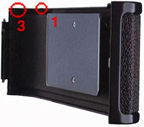 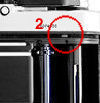 |
Wondering how the counter reset when the camera back is opened ? May be I could explain to you what is the mysterious pin (2) hiding at the film back rail are made for. Open your camera back and you will notice at the top of the film back are not straight (Newer designs are not obvious, only a slight contoured outline was moulded closer to the film back release latch (3)). |
When the film back is closed, the edge will trigger the pin on the camera body and activate the mechanism of the frame counter. When the film back is opened and cause the connection broke off, it will activate and reset another mechansim to reset the counter to be pre-frame position.This mechanism is full mechanical. Almost all cameras use this theory.. errr. I have the check the lastest F5 first, ha!
Film Advance Lever
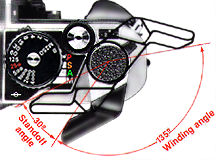 |
To advance the film, wind the lever to the right completely until it stops The lever returns to the standoff position as soon as you take your thumb off the lever. A single complete stroke advances the film one frame and simultaneously cocks the shutter. |
The film advance lever in the FA wasn't designed as with the F series camera models, where it cannot use multiple of short strokes to complete a full stroke. When it is flush with the camera body, it acts as a safety lock (You cannot trip the shutter release then). When the film advance lever is at the 30° "stand-off" angle, the camera's electronics will activate. Just depress half way on the shutter release button will also turns the metering on.
Unloading the
Film
When the
film reaches the end of the roll, the film advance lever cannot be wound any
further. Don't apply any force then. Check the counter and see if it has
reaches 'around' theoretical limit of the film in use. Or sometimes, you need
to rewind the film in mid-roll in situations like changing a another film with
different film speed etc., for whatever the reasons, you need to rewind and
unload the film, just follow the procedures here:
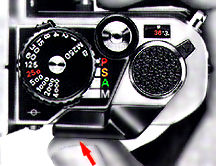 |
1. Push the film advance lever back into place to turn off the camera and lock the shutter release button. This action prevents inadvertent shutter release and save some battery power... |
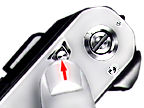 |
2. Depress the rewind button that locates on the bottom of the camera. You don't have to apply continuous pressure to the button: just press it once that will do. |
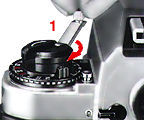 |
|
4. Open the camera back and take out film cartridge by pushing the safety lock and pull up the rewind knob (Refer back to loading sequence). Avoid unloading in direct sunlight. If there is no shade available, turn your back to the sun and use your own shadow to shield the camera.
It is not advisable to keep
the film leader out - unless with a purpose. This is especially true when you
are working with high volume assignments. It could be easily mix up with the
unexposed rolls. In some situations where you need to reload a partially
exposed roll for shooting like possible situation we explained earlier (Set
the correct film speed again), set the shutter speed dial to 1/4000 sec, turn
the aperture value to the minimum (f16, f22 or f32), put the lens cap back on
with your hand to shield it, turn on the eyepiece shutter blind, if possible
do it in a dark environment and then reload the film. You need to go back to
the original frame number and buy some insurance by add or wasting few blank
shots extra to avoid overlapping of expsoures. Warning:
NEVER
attempt this method if you are new to this, it needs some good experience to
handle this task.
Memo Holder
Unless you have bought a used
FA with a databack attached, the normal film back has a memo holder behind the
film back. The Nikon FA has no automatic DX coding to do auto film speed
recognition (If I can still recall, the F301 is, huh ?). You can tear out the
side of the film box, and insert a film box end in the memo holder to remind
you of the type of film in use. Or you take take down the photodata and store
it here manually. Newer AF camera models has removed this feature from the
spec sheet, but it comes in very handy for seasoners.
The first three
parts complete the setup for the FA. We will start off with the preparation of
the camera for exposures.
 The additive type
frame counter is graduated from S, two dots, 1, 2, 4 - up to 36 in
even numbers with odd numbers indicated by white dots in between. The
frame counter advances a single frame by one complete stroke of the
film advance lever. After reaching frame 36 of a 36 exposure roll of
film, the counter will not operate. however, film will be advanced
until the actual end of the film roll. The frame counter automatically
resets to S when the camera back is opened. In multiple exposure mode,
the frame counter does not advance when the multiple exposure lever
has been activated.
The additive type
frame counter is graduated from S, two dots, 1, 2, 4 - up to 36 in
even numbers with odd numbers indicated by white dots in between. The
frame counter advances a single frame by one complete stroke of the
film advance lever. After reaching frame 36 of a 36 exposure roll of
film, the counter will not operate. however, film will be advanced
until the actual end of the film roll. The frame counter automatically
resets to S when the camera back is opened. In multiple exposure mode,
the frame counter does not advance when the multiple exposure lever
has been activated.